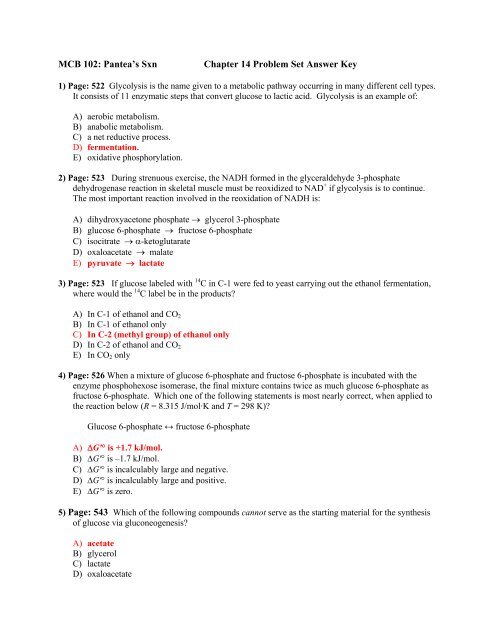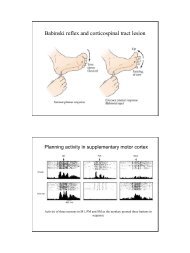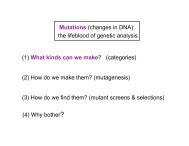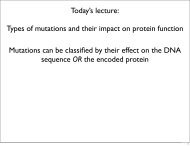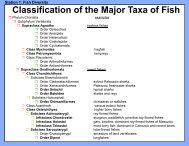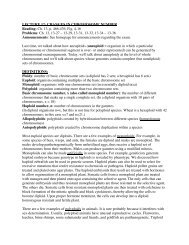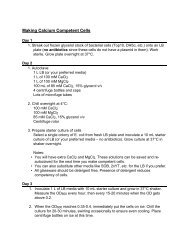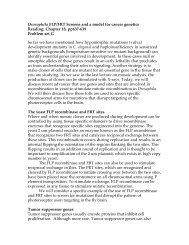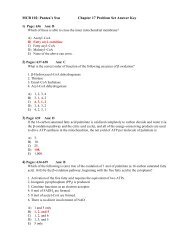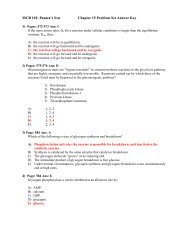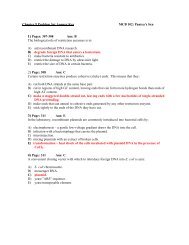MCB 102: Pantea's Sxn Chapter 14 Problem Set Answer Key
MCB 102: Pantea's Sxn Chapter 14 Problem Set Answer Key
MCB 102: Pantea's Sxn Chapter 14 Problem Set Answer Key
You also want an ePaper? Increase the reach of your titles
YUMPU automatically turns print PDFs into web optimized ePapers that Google loves.
<strong>MCB</strong> <strong>102</strong>: Pantea’s <strong>Sxn</strong> <strong>Chapter</strong> <strong>14</strong> <strong>Problem</strong> <strong>Set</strong> <strong>Answer</strong> <strong>Key</strong><br />
1) Page: 522 Glycolysis is the name given to a metabolic pathway occurring in many different cell types.<br />
It consists of 11 enzymatic steps that convert glucose to lactic acid. Glycolysis is an example of:<br />
A) aerobic metabolism.<br />
B) anabolic metabolism.<br />
C) a net reductive process.<br />
D) fermentation.<br />
E) oxidative phosphorylation.<br />
2) Page: 523 During strenuous exercise, the NADH formed in the glyceraldehyde 3-phosphate<br />
dehydrogenase reaction in skeletal muscle must be reoxidized to NAD + if glycolysis is to continue.<br />
The most important reaction involved in the reoxidation of NADH is:<br />
A) dihydroxyacetone phosphate → glycerol 3-phosphate<br />
B) glucose 6-phosphate → fructose 6-phosphate<br />
C) isocitrate → α-ketoglutarate<br />
D) oxaloacetate → malate<br />
E) pyruvate → lactate<br />
3) Page: 523 If glucose labeled with <strong>14</strong> C in C-1 were fed to yeast carrying out the ethanol fermentation,<br />
where would the <strong>14</strong> C label be in the products?<br />
A) In C-1 of ethanol and CO2<br />
B) In C-1 of ethanol only<br />
C) In C-2 (methyl group) of ethanol only<br />
D) In C-2 of ethanol and CO2<br />
E) In CO2 only<br />
4) Page: 526 When a mixture of glucose 6-phosphate and fructose 6-phosphate is incubated with the<br />
enzyme phosphohexose isomerase, the final mixture contains twice as much glucose 6-phosphate as<br />
fructose 6-phosphate. Which one of the following statements is most nearly correct, when applied to<br />
the reaction below (R = 8.315 J/mol·K and T = 298 K)?<br />
Glucose 6-phosphate ↔ fructose 6-phosphate<br />
A) ΔG'° is +1.7 kJ/mol.<br />
B) ΔG'° is –1.7 kJ/mol.<br />
C) ΔG'° is incalculably large and negative.<br />
D) ΔG'° is incalculably large and positive.<br />
E) ΔG'° is zero.<br />
5) Page: 543 Which of the following compounds cannot serve as the starting material for the synthesis<br />
of glucose via gluconeogenesis?<br />
A) acetate<br />
B) glycerol<br />
C) lactate<br />
D) oxaloacetate
E) α-ketoglutarate<br />
6) Page: 549 The main function of the pentose phosphate pathway is to:<br />
A) give the cell an alternative pathway should glycolysis fail.<br />
B) provide a mechanism for the utilization of the carbon skeletons of excess amino acids.<br />
C) supply energy.<br />
D) supply NADH.<br />
E) supply pentoses and NADPH.<br />
7) Page: 523 Show how NADH is recycled to NAD + under aerobic conditions and under anaerobic<br />
conditions. Why is it important to recycle NADH produced during glycolysis to NAD + ?<br />
Ans: Cells contain a limited supply of NAD + and NADH. The oxidation of glyceraldehyde 3phosphate<br />
requires NAD + as as electron acceptor—it converts NAD + to NADH. Unless this<br />
NADH is recycled to NAD + , oxidative metabolism in this cell will cease for lack of an electron<br />
acceptor. Under aerobic conditions, NADH passes electrons to O 2 ; under anaerobic conditions,<br />
NADH reduces pyruvate to lactate, and is thereby recycled to NAD + .<br />
8) Page: 526<br />
In the conversion of glucose to pyruvate via glycolysis, all of the following enzymes participate.<br />
Indicate the order in which they function by numbering them.<br />
1 hexokinase<br />
_4__ triose phosphate isomerase<br />
_2__ phosphohexose isomerase<br />
_6__ enolase<br />
_5__ glyceraldehyde 3-phosphate dehydrogenase<br />
_7__ pyruvate kinase<br />
_3__ phosphofructokinase-1<br />
Which of the enzymes represents a major regulation point in glycolysis?<br />
Which catalyzes a reaction in which ATP is produced?<br />
Which catalyzes a reaction in which NADH is produced?<br />
Ans: 4; 2; 6; 5; 7; 3; phosphofructokinase-1; pyruvate kinase; glyceraldehyde 3-phosphate<br />
dehydrogenase<br />
9) Page 528 The conversion of glyceraldehyde 3-phosphate to dihydroxyacetone phosphate is<br />
catalyzed by triose phosphate isomerase. The standard free-energy change (ΔG'°) for this reaction is<br />
–7.5 kJ/mol. Draw the two structures. Define the equilibrium constant for the reaction and calculate<br />
it using only the data given here. Be sure to show your work. (R = 8.315 J/mol·K; T = 298 K)<br />
Ans: See Fig. 15-4, p. 535.<br />
Keq' = [glyceraldehyde 3-phosphate]<br />
[dihydroxyacetone phosphate]<br />
ΔG'° = –RT ln Keq'<br />
ln Keq' = �ΔG'º
RT<br />
ln Keq' = ____7,500 J/mol____ = 3.027<br />
(8.315 J/mol·K)(298 K)<br />
Keq' = 20.6


